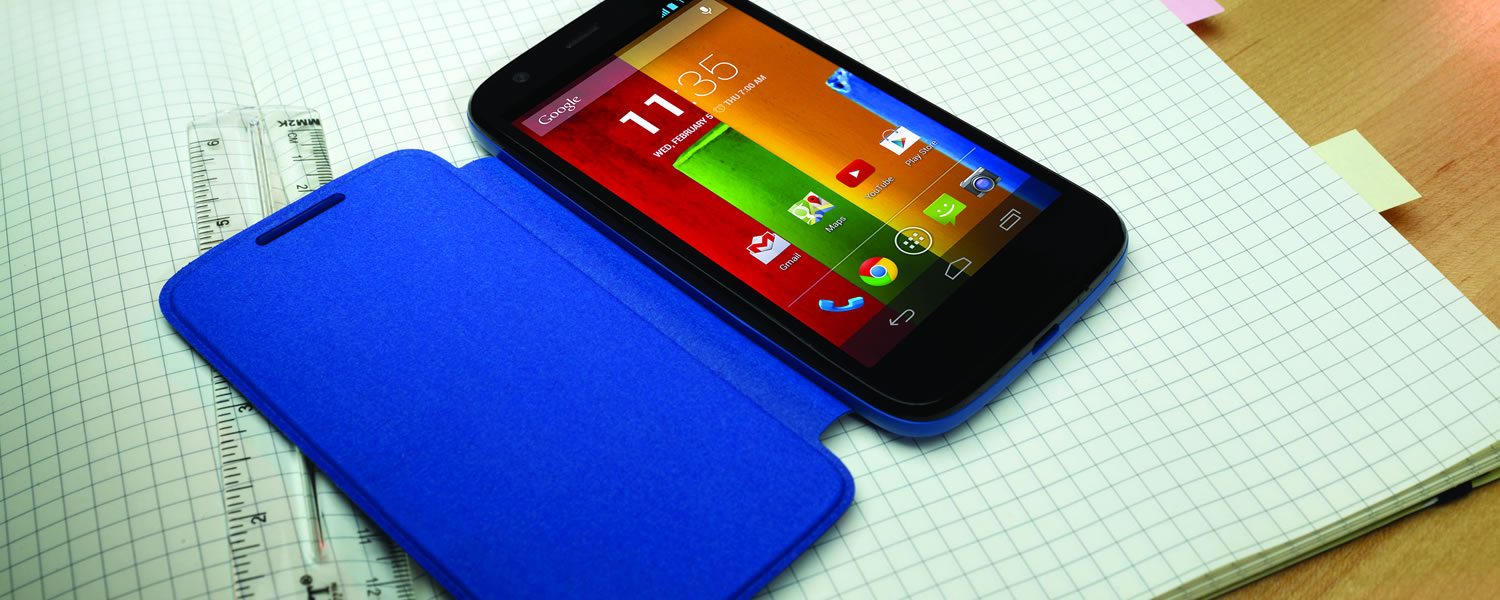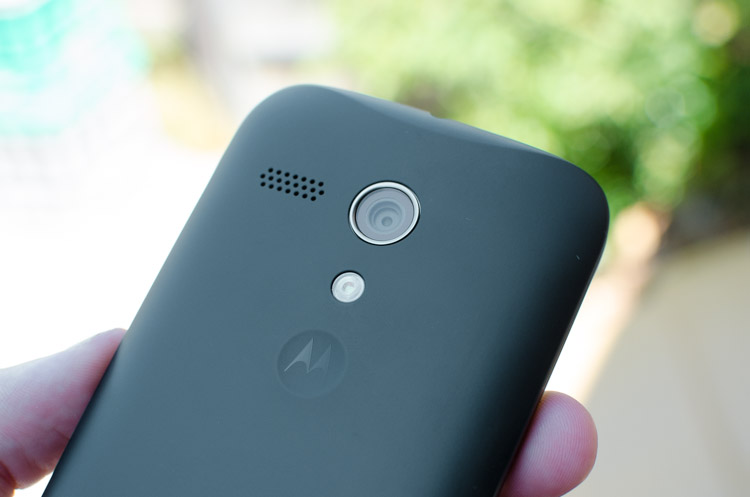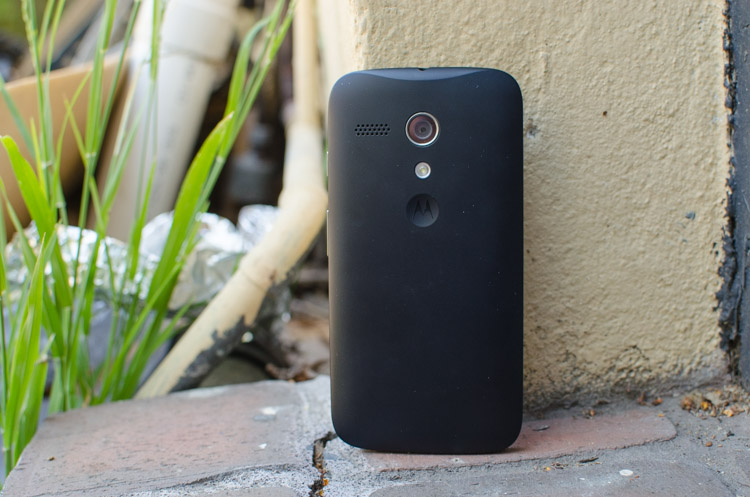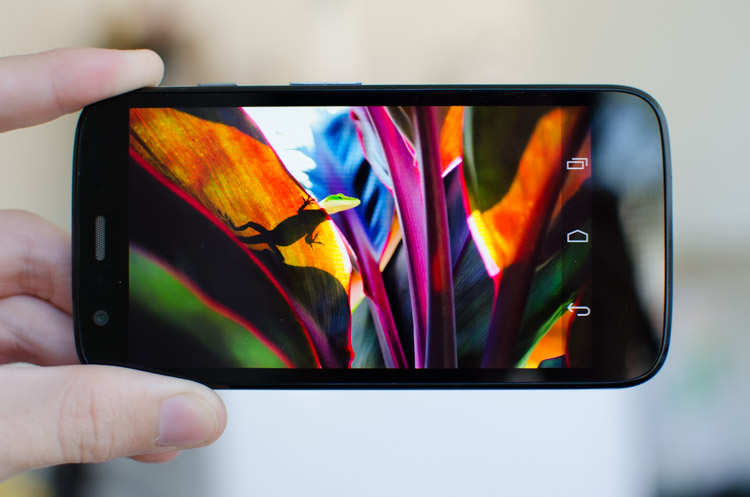The entry-level smartphone market is fierce, as most companies end up selling vastly more cheap phones than expensive ones. A case-in-point is the Nokia Lumia 520, which sells for under $100 and occupies the largest chunk of Windows Phone market share by far. When it comes to Android, there's considerably more competition, with various Asian OEMs pushing their cheap, often unknown devices hard in local markets.
Motorola Moto G - $179 - $199 (unlocked)
- 4.5", 1280 x 720 LCD display (326 ppi)
- Qualcomm Snapdragon 400 SoC
- 1.3 GHz quad-core CPU, Adreno 305 GPU, 1GB RAM
- 8 or 16 GB internal storage
- 5 MP camera, 1/4" sensor, f/2.4 lens, 720p video
- 2,070 mAh, 7.87 Wh battery
- HSPA+, Wi-Fi b/g/n, Bluetooth 4.0
- Stock Android 4.3 'Jelly Bean'
- 143 grams, 11.6mm thick
The Moto G is Motorola's biggest and best effort yet in conquering the entry-level market. It's not a handset meant to break records, but the 4.5-inch 720p display, Qualcomm Snapdragon 400 SoC and dual-SIM support (in certain models) will please the right crowds. Plus, at $179 for the 8 GB model and $199 for 16 GB, unlocked and off-contract, it certainly fits the definition of what an affordable smartphone should be.
As with most budget oriented Android devices, the question remains as to whether performance and overall build quality is up to scratch. We've all experienced terrible OS and app performance from cheap, crappy Android phones in the past, so let's hope the Moto G doesn't fall into this trap.
The Moto G unit used in this review was kindly provided by MobiCity. They have the best range of unlocked, off-contract smartphones, and they ship to most countries globally.
Design
The Moto G's frame is built around a 4.5-inch display, so compared to today's 5-inch flagship handsets, the device is relatively compact. It's not the best looking smartphone I've ever used, nor is it the thinnest or lightest - the Moto G comes in at 11.6mm thick and 143 grams heavy - but the edges are curved to make it ergonomic.
It's not surprising to discover that the majority of the Moto G is made from plastic. The good news is that Motorola hasn't opted for glossy, Samsung-style cheap plastic, despite the price point of the handset. The back panel, which incidentally is removable, is made from soft-touch, rubberized plastic that feels great to the touch, and the front panel is covered with smooth Gorilla Glass 3. The Moto G's build quality is quite good and the device overall feels tough.
The handset's rear design is reminiscent of its bigger brother, the Moto X. While you don't get the same sort of customization options or patterns, the Moto G's back is curved in the same fashion, and includes the exact same indentation that houses the Motorola logo. Above this logo sits the camera and LED flash, and to the left of these is the rear speaker. The speaker isn't hugely powerful, nor is it close to being good quality, but it fullfills the job.
Like most phones, the Moto G's front profile is bare and minimalist, save for the 4.5-inch display that occupies roughly 65% of the total panel. Aside from the front-facing camera and in-call speaker, the only interesting thing about the Moto G's front is the lack of hardware buttons, opting instead for on-screen buttons. The display is positioned towards the top, so that the on-screen buttons are easier to press, which is an ergonomic choice I approve of.
Speaking of ergonomics, Motorola has chosen the perfect position for the power button, which can be found on the right-hand edge of the Moto G. When you're holding the device, the power button is in the exact spot I would normally place my thumb (if held in my right hand) or forefinger (if held in my left hand), making it a breeze to turn the handset on or off. Other features around the edge, including the volume rocker, microUSB port and 3.5mm headphone jack, are in their usual positions.
There are no SIM card slots around the edge of the device, and that's because they're located behind the removable rear panel. By pulling up from the area near the USB port, the surprisingly strong rear cover comes off without a great deal of effort. There's no removable battery, nor a microSD card slot (I'll discuss this further later on), but you will find the micro-SIM card slot.
The particular model I reviewed is the dual-SIM variant of the Moto G, so there are two SIM card slots underneath the back cover: one at the top right, and one at the bottom left. When there's two slots to place somewhere on the device it makes a bit of sense to have the entire back cover remove, but it's an unusual choice for the single-SIM variant, especially as the battery is sealed behind another layer of plastic.
As an entry-level device, the Moto G's design is ergonomic and usable. I'm glad Motorola didn't choose bargain basement materials, sticking to soft-touch plastic and Gorilla Glass on this relatively compact device.
Display
On paper, the 4.5-inch 1280 x 720 TFT LCD panel Motorola has chosen for the Moto G presents great value. While some manufacturers are bumping their lower-end handsets up to 720p display resolutions, many - including Nokia for their Lumia 525 - aren't, instead sticking with WVGA. This makes the Moto G's 326 PPI display seem fantastic in comparison.
I was honestly surprised at just how good the display of the Moto G is, considering how much the device costs. Sure, it's not the best display I've ever used, but for a non-IPS (likely TN) panel, color accuracy and saturation is good. There's some visible color banding when viewing smooth gradients, but for the most part images look really good on this affordable handset.
Some aspects of the Moto G's display, though, definitely fall behind those we've been accustomed to on top-end smartphones. Maximum brightness from the backlight is quite good, but the apparently lack of filter layers can make the Moto G hard to read in strong daylight. Contrast isn't terrible, but a noticeable amount of backlight seeps through, preventing the panel from displaying deep blacks, and hurting the overall contrast ratio.
As mentioned earlier, the Moto G uses on-screen buttons as opposed to traditional capacitive hardware buttons. While the screen itself is 4.5-inches large with 55.8 square centimeters of real estate, the on-screen buttons reduce the usable space to 4.2 inches. Despite this, I'm a fan of on-screen buttons, as they can change and disappear in certain applications when necessary. Plus, you get the proper array of Android buttons in the correct order: back, home, app switcher.
With most high-end smartphones packing 5-inch displays as standard these days, the Moto G's screen real estate isn't huge, and yet the iPhone 5s still continues Apple's small-screen tradition with a 4-inch panel, making the Moto G's display larger than Apple's flagship.
Motorola also has kept the G quite compact, appealing to users who don't want a cumbersome large-screen handset, and for all intents and purposes the Moto G has plenty of screen space for videos and games. I started using the Moto G right after using the Samsung Galaxy Note 3 and Nokia Lumia 1520, which are massive in comparison, but the G is more comfortable to use.
Packing a 1280 x 720 resolution, the Moto G's display is very sharp for its class. 1080p panels are all the rage at the moment, and in the right conditions you can tell the difference, but in regular usage this 720p LCD panel is crisp and great to view. It benefits from a standard RGB stripe subpixel layout, meaning there's no PenTile AMOLED artefacts, so text is largely jaggie-free.
I was expecting a worse display on the Moto G than Motorola actually delivered, which of course is fantastic to see. The 4.5-inch panel does a wonderful job for the cost of the handset.










